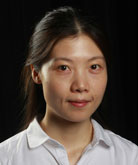Portable Inventions
Testing sickle-cell and other blood-related diseases are now as simple as testing a drop of blood at home, according to the recent patent application filed by Sarah Du, Ph.D., an associate professor in the College of Engineering and Computer Science.
Du, a mechanical engineer and inventor, said the portable device is able to diagnose and monitor patients’ blood activity, a tool that was missing previously in the lab. “It can also provide a diagnosis for patients in a matter of minutes compared to commercial laboratories which could often take days to share results,” Du said.
Her device is an instrument that uses very small amounts of fluid — or blood — on a microchip to run tests. By taking a small drop of blood, patients can determine if they have diseases like sickle cell anemia and work on treatment methods sooner rather than later, she said.
Before Du became an inventor, working with FAU’s Office of Technology Development to patent her device, she began her journey in 2011 by studying red blood cells and how they function in diseases.
“Making microfluidic portable devices that allow patients and health-care providers to have an easier solution to diagnosing diseases is a major part of my work and my passion, I know these devices have the potential to advance the way we treat patients,” she said.
Here is more information about Du, in her own words:
How did you first become interested in research?
It is hard to define the "first" time that I became really interested in research. I think as for me, it has been a rather gradual progress. I liked the hands-on environment of being in the lab when I was doing my PhD. I enjoyed the independence and freedom during my postdoc training that I get working at the interface of engineering, physics, and biology. It allowed me to think in a broader and creative way. My interest in research ever increases along my journey.
What makes you most excited about research?
I am most excited about the interdisciplinary nature of our research in microfluidics. It is a highly versatile and precise tool for modeling and study human physiology and diseases. Research allows me to always try new ideas and experiment with the applications of one technique commonly seen in a discipline to provide an ingenious solution to a grand problem in another discipline.
Tell me about your most interesting research accomplishment.
Fatigue testing is a well-established mechanical testing technique to demonstrate the safety of a structure material and biomaterials that may be susceptible to fatigue (cyclic loading). However, such testing had been almost impossible for microscopic biological cells. We invented a biomechanical testing method that has realized fatigue testing of biological cells for the first time. We are now in collaboration with several research labs within the states and abroad to perform fatigue testing on varied cell types.
What new developments and innovations can we expect to see in your research in the next 5 years?
We anticipate innovations in microfluidics to accelerate point-of-care diagnosis and post-therapy monitoring in blood diseases. This is related to my patent on sickle-cell disease testing. Patients will be able to use a drop of blood from the prick of their finger to test for diseases right at home.
Discuss a positive experience with the Office of Technology Development.
We had several great experiences with OTD in filing our non-provisional and provisional patent applications. Dana and her team always provide us excellent advice and professional support.
What is an interesting fact that people at FAU may not know about you?
Gardening is my favorite hobby. A rewarding and gratifying way to destress.
